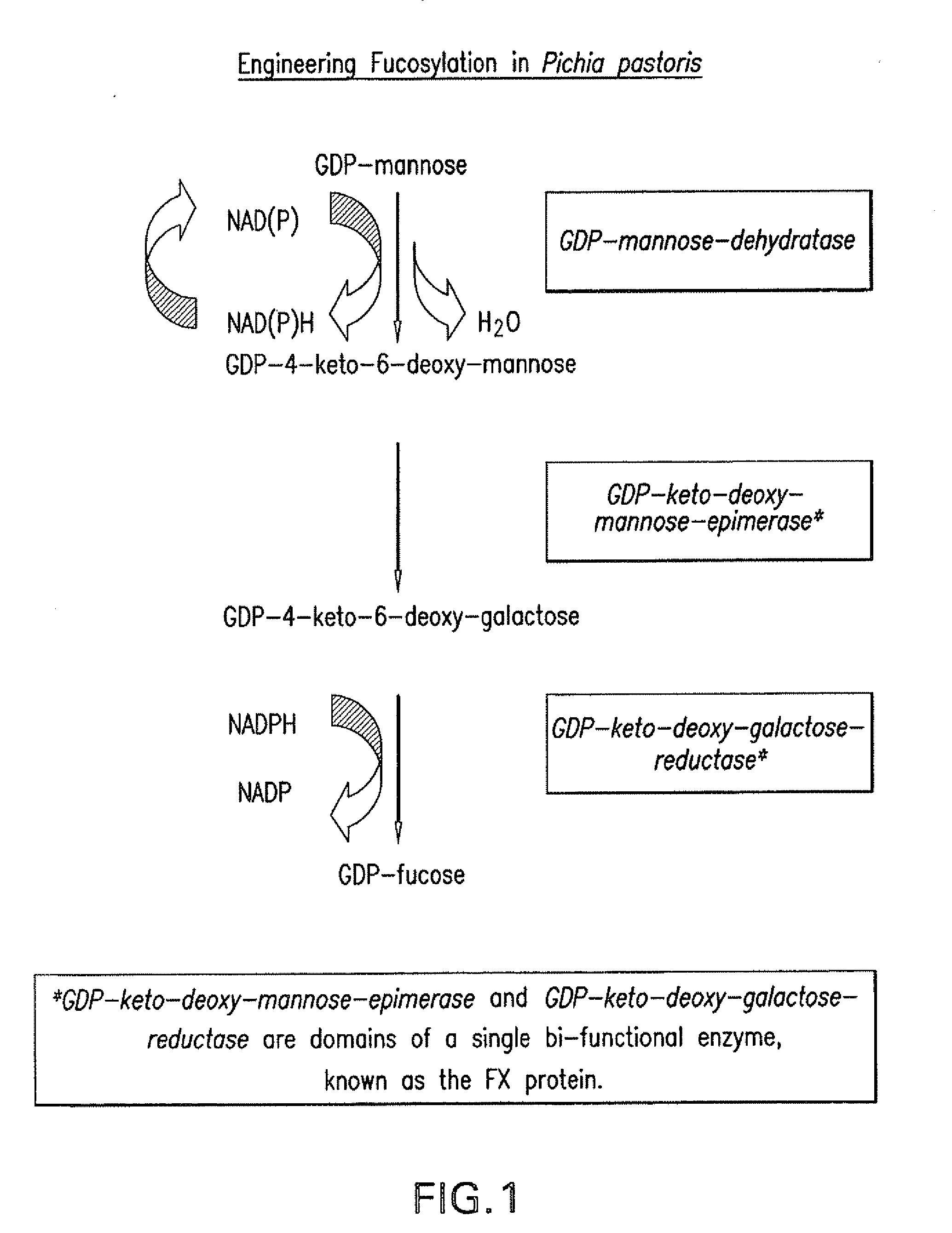Production of glycoproteins with modified fucosylation
a technology of fucosylation and glycoprotein, applied in the field of glycoprotein production, can solve the problems of unfavorable protein yield comparison, complex and expensive nutrients and cofactors in cell culture systems, and slow animal cell culture systems, so as to enhance protein stability, enhance translation efficiency, and stabilize the cytoplasmic mrna
- Summary
- Abstract
- Description
- Claims
- Application Information
AI Technical Summary
Benefits of technology
Problems solved by technology
Method used
Image
Examples
example 1
[0070]This Example shows the construction of a Pichia pastoris strain capable of producing glycoproteins that include fucose in the N-glycan structure of the glycoprotein.
[0071]Escherichia coli strains TOP10 or XL10-Gold are used for recombinant DNA work. PNGase-F, restriction and modification enzymes are obtained from New England BioLabs (Beverly, Mass.), and used as directed by the manufacturer. α-1,6-Fucosidase is obtained from Sigma-Aldrich (St. Louis, Mo.) and used as recommended by the manufacturer. Oligonucleotides are obtained from Integrated DNA Technologies (Coralville, Iowa). Metal chelating “HisBind” resin is obtained from Novagen (Madison, Wis.). 96-well lysate-clearing plates are from Promega (Madison, Wis.). Protein-binding 96-well plates are from Millipore (Bedford, Mass.). Salts and buffering agents are from Sigma-Aldrich (St. Louis, Mo.).
Amplification of Fucosylation Pathway Genes.
[0072]An overview of the fucosylation pathway is shown in FIG. 1. The open reading fr...
example 2
[0090]A Pichia pastoris strain capable of producing glycoproteins having NANA2Gal2GlcNAc2Man3GlcNAc2(Fuc) N-glycans can be made by introducing the vector pSH1022 into a Pichia pastoris strain capable of producing glycoproteins having NANA2Gal2GlcNAc2Man3GlcNAc2 N-glycans. For example, vector pSH1022 containing the genes encoding the components of the fucosylation pathway can be transformed into the strain YSH597, which produces rat EPO having NANA2Gal2GlcNAc2Man3GlcNAc2 N-glycans and is disclosed in U.S. Provisional Application No. 60 / 801,688 and Hamilton et al. Science 313, 1441-1443 (2006). The rat EPO produced in the strain upon induction will include NANA2Gal2GlcNAc2Man3GlcNAc2(Fuc) N-glycans.
[0091]The following provides a prophetic method for introducing the enzymes encoding the sialylation pathway into strain YSH661 of Example 1.
[0092]Open reading frames for Homo sapiens UDP-N-acetylglucosamine-2-epimerase / N-acetylmannosamine kinase (GNE), H. sapiens N-acetylneuraminate-9-phos...
example 3
[0095]A Pichia pastoris strain capable of producing a human EPO having NANA2Gal2GlcNAc2Man3GlcNAc2(Fuc) N-glycans can be made by introducing the vector pSH1022 into a Pichia pastoris strain capable of producing human EPO having NANA2Gal2GlcNAc2Man3GlcNAc2 N-glycans. For example, vector pSH1022 containing the genes encoding the components of the fucosylation pathway can be transformed into a strain that is capable of producing glycoproteins having NANA2Gal2GlcNAc2Man3GlcNAc2 N-glycans, such as strain YSH597 disclosed in Hamilton et al., Science 313, 1441-1443 (2006) or YSH661 of Example 2 comprising the genes encoding the sialylation pathway enzymes but replacing the DNA encoding rat EPO with DNA encoding the human EPO. The strain will then produce human EPO having NANA2Gal2GlcNAc2Man3GlcNAc2(Fuc) N-glycans.
[0096]While the present invention is described herein with reference to illustrated embodiments, it should be understood that the invention is not limited hereto. Those having ord...
PUM
| Property | Measurement | Unit |
|---|---|---|
| pH | aaaaa | aaaaa |
| pH | aaaaa | aaaaa |
| catalytic | aaaaa | aaaaa |
Abstract
Description
Claims
Application Information
 Login to View More
Login to View More - R&D
- Intellectual Property
- Life Sciences
- Materials
- Tech Scout
- Unparalleled Data Quality
- Higher Quality Content
- 60% Fewer Hallucinations
Browse by: Latest US Patents, China's latest patents, Technical Efficacy Thesaurus, Application Domain, Technology Topic, Popular Technical Reports.
© 2025 PatSnap. All rights reserved.Legal|Privacy policy|Modern Slavery Act Transparency Statement|Sitemap|About US| Contact US: help@patsnap.com



